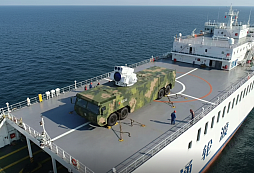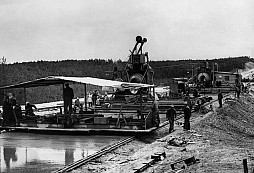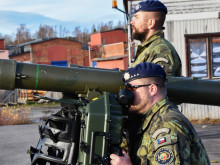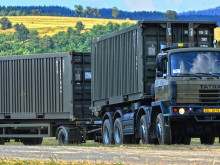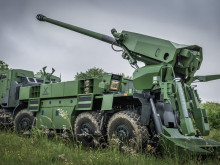The MV-3 mine thrower and unique ammunition provides a unique ability to set up minefields
Unique tactical weapon system in NATO armies. This is how our alliance partners evaluate the remote minelaying system of the Czech manufacturer STV GROUP. The MV-3 mine thrower is the only device in the Army of the Czech Republic designed to set up anti-tank minefields remotely. In less than two minutes, it is capable of minesweeping an area of 1 hectare and can reach a distance of up to 3 kilometres. Only the 15th Engineer Regiment has the mine thrower in its armament. Specifically, it has 8 pieces in the Bechyně garrison, 8 pieces in the Olomouc garrison and one specimen is also used for training purposes by the Military Academy in Vyškov. The mine thrower can fire either from the ground or from the cargo compartment of the Tatra 810 and its operator consists of two people. The uniqueness of the system is mainly due to the modernized 122-KS ammunition.
 Picture: The MV-3 mine thrower is the only device in the Army of the Czech Republic designed to set up anti-tank minefields remotely. | 15th Engineer Regiment
Picture: The MV-3 mine thrower is the only device in the Army of the Czech Republic designed to set up anti-tank minefields remotely. | 15th Engineer Regiment
The mine thrower system with 122-KS ammunition is used to barricade a specific tactical location, e.g. a backbone road, a pass or an intersection. In this case, it is intended to stop, divert, or at least slow the enemy's advance. The system can be used effectively in its own controlled territory or in enemy territory, even in the vicinity of enemy units. "This capability is unique in NATO armies," says Capt. Jan Kuthan, commander of the 1st Task Group, describing the current role of mine throwers. The 1st Task Force is currently operating with this system in Latvia, where the main task of the Czech engineers is to inform coalition partners how to use the mine thrower system properly, what the benefits are and what the MV-3 can do and can offer to all-military commanders. The commanders can then count on and use this capability in their battle planning. The mine thrower is capable of both direct and indirect fire.
We were interested in how such a container anti-tank minelayer works and how its production is carried out, so we visited the manufacturer of this ammunition, STV GROUP a.s., where the missile under the company name "Križná" was presented to us in detail.
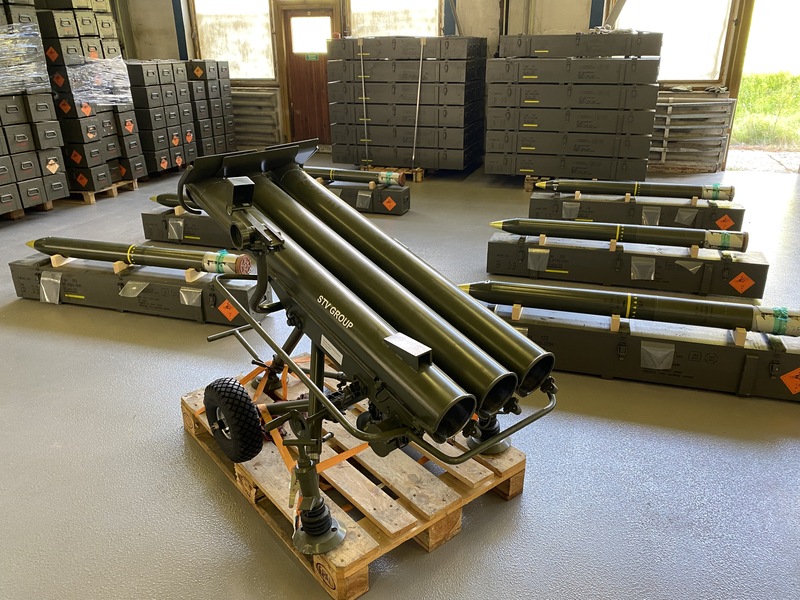 Picture: MV-3 mine thrower, 122 mm calibre | Michal Pivoňka / CZ DEFENCE
Picture: MV-3 mine thrower, 122 mm calibre | Michal Pivoňka / CZ DEFENCE
The exact name of the ammunition is STŘELA 122-KS PTMi-D1M. It is a container missile with anti-tank mines, the missiles are reactive propelled and equipped with a pyrotechnic timing fuse. Each containerised missile contains a total of 4 mines and up to 3 containerised missiles can then be fired in a salvo via the 122 mm MV-3 mine thrower. By adjusting the igniter, it is possible to ensure that anti-tank mines can be "blown" out of the missile container at distances of 500-3,000 metres, every 500 metres.
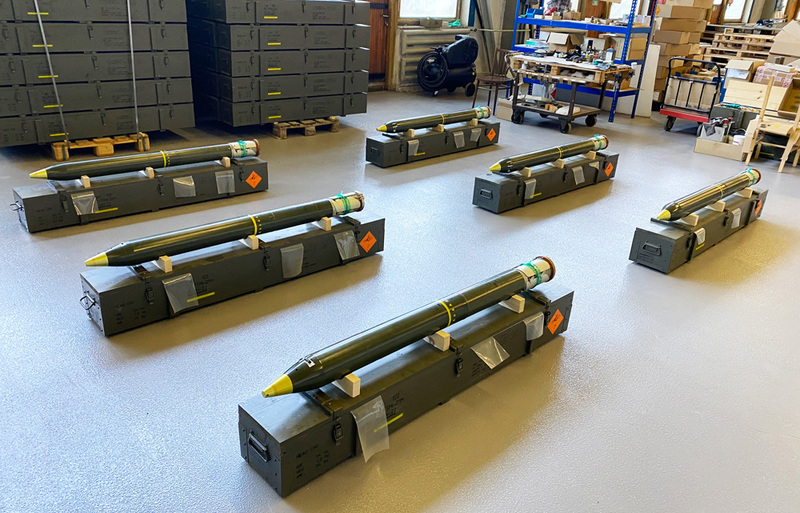 Picture: Each containerised missile contains a total of 4 mines and the MV-3 122 mm mine thrower can launch up to 3 containerised missiles in a salvo. | Michal Pivoňka / CZ DEFENCE
Picture: Each containerised missile contains a total of 4 mines and the MV-3 122 mm mine thrower can launch up to 3 containerised missiles in a salvo. | Michal Pivoňka / CZ DEFENCE
However, the system is also capable of individual distance adjustment. One volley from the MV-3 launcher, which fires 3 container missiles, is then able to cover a square area of 100x100 meters with 12 mines. Two throwers are then able to cover three square spaces. In order to provide an effective minefield density against enemy tanks and infantry fighting vehicles, 2 salvos (each from one thrower) should be fired into one target square, thus minesweeping the area with a total of 24 mines, which is more than sufficient mine density to be effective against enemy armoured units.
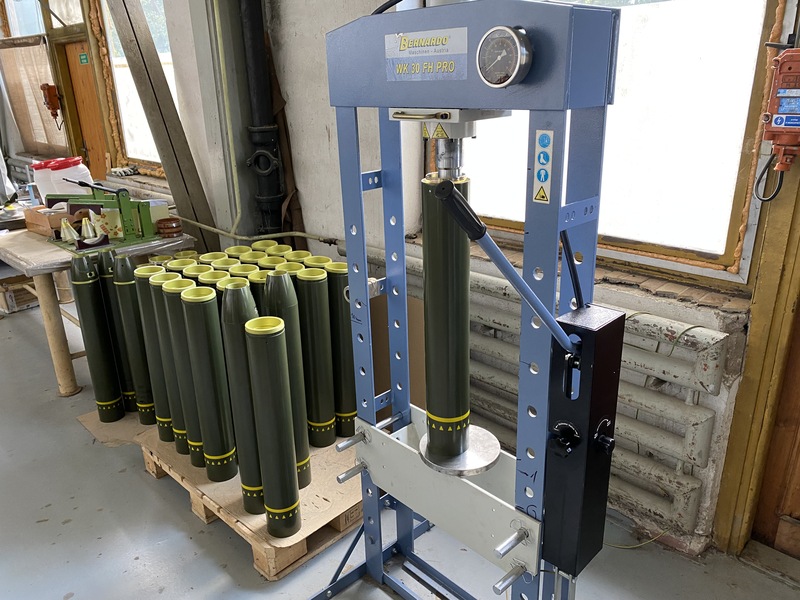
Picture: Container missile assembly | Michal Pivoňka / CZ DEFENCE
The minesweeping of an area by means of container missiles has a particularly strong psychological effect on the enemy, as he first identifies an area as "clear" based on reconnaissance by forward units, but then the area is mined within moments and is essentially impassable. The primary objective of the mines is not to destroy the enemy machine completely, but just to immobilize it, stop the enemy advance, or bring fire support to the area. The individual mines leave the container missile at the required distance and fall to the ground via a parachute.
After the mine hits the ground, the mine is positioned in a combat position in the field (via the automatically positioned feet of the positioning mechanism) and is immediately activated when it calibrates to the surrounding electromagnetic field. If the mine detects that the ambient electromagnetic field has changed or has been disturbed, the system assesses that a target is approaching and the mine is initialized, detonating the mine's top cover, under which the infrared sensor is located. The sensor is then activated when the vehicle is driven over the mine and the detonation occurs with some delay.

The upgraded mine contains smart electronics that react only to vehicles not people, where its initiation is based only on a change in magnetism and via an infrared emitter. Mines must also have a self-destruct system under the Ottawa Convention. The mine also contains an anti-handling system that detonates the mine should, for example, enemy engineers discover it and wish to deactivate it. Interestingly, the original drawings of the container missile date back to 1984 or 1986, and the missile was introduced to the Czech Armed Forces in the 1990s, when it was supplied to the army on a regular basis until 1997. Later, the production of a modernised container missile with new electronics and sensors began, and in 2021 a contract was signed with the Ministry of Defence of the Czech Republic for the delivery of these missiles to the Czech Armed Forces, worth a total of CZK 460 million. Hundreds of missiles are currently delivered to the Czech Armed Forces every year.
The production of the mine starts with the production of the electronic block, which includes the installation of sensors, power supply, burners and other components. The electronic block is then switched on in the mine body to protect the electronics during firing and impact, and the top of the mine is fitted with a protective cover. The mine is then fitted with a press-fitted and assembled charge consisting of the trigger body, the charge itself and the cup. The mine is sealed with a protective cover on which the sensor and pressure sensor are mounted. A slide with a detonator shall be fitted into the mine opening and secured with a needle, the other end of which shall be attached to the parachute. A positioning mechanism is attached to the bottom of the mine, the legs of which are fixed with a steel cable with a pyrospring attached after the lid and parachute are seated. After the positioning mechanism is fixed, a ring is fitted to the mine, into which the parachute is placed and covered with a spring-loaded cover. Everything is continuously checked and tested. The overall functionality of the finished mine is then checked several more times. The container is then loaded with 4 mines interconnected by a self-destruct cable, which is used to set the self-destruct time of each mine. After the 4 interconnected mines have been inserted into the container, a plunger is placed on the last mine to sweep the mines out of the container at the desired sweep time set on the PCZ-22A to achieve the correct mine site in the range of 500 to 3 000 metres by 500 metres. The container is closed with a hood which contains a connector for connecting the launcher and setting device. The container, thus assembled with 4 mines, is screwed onto the rocket motor. The PČZ-22A igniter is screwed into the hole in the hood in the secured position. The containerised KS PTMi-D1M munition thus debugged is stenciled and placed in a chest which is sealed and sealed with the seals of the laboratory plant. The filled boxes with KS PTMi-D1M shall be placed on a pallet. The full pallet is sealed with steel cyclo tape and handed over to the finished goods warehouse for subsequent dispatch to the customer. It takes approximately eleven hours just for one containerized projectile to be laboratory tested.
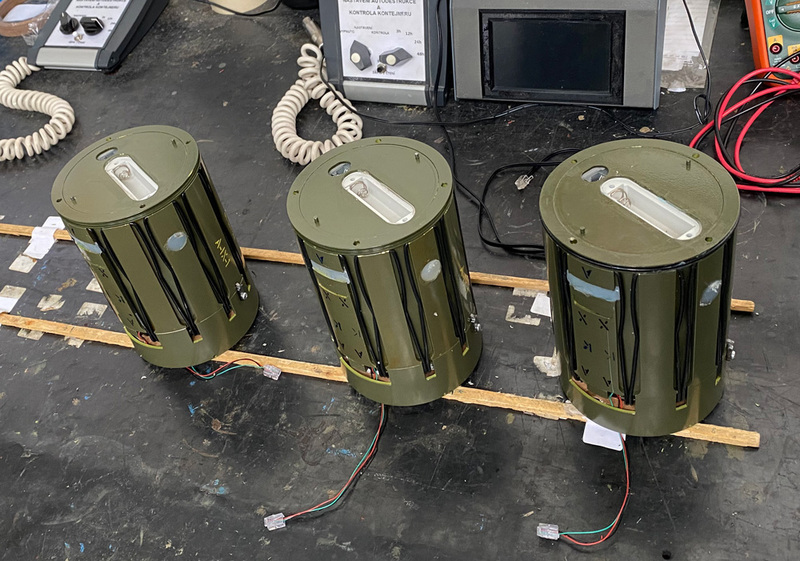 Picture: The production of the mine starts with the production of the electronic block, within which the installation of sensors, power supply, burners and other components takes place. | Michal Pivoňka / CZ DEFENCE
Picture: The production of the mine starts with the production of the electronic block, within which the installation of sensors, power supply, burners and other components takes place. | Michal Pivoňka / CZ DEFENCE
The mine thrower is operated by our soldiers directly from the field or from the loading area of the Tatra 810, but in the future STV GROUP a.s. intends to offer the army a mine thrower on a mobile platform, for example in the form of an off-road vehicle.
We asked the deputy commander of the 15th Engineer Regiment, Colonel Jiří Machona, about the MV-3 mine thrower in the service of the Czech Army:
How do you perceive the MV-3 system in terms of its unique capability? To what extent does this system provide you with a certain tactical advantage?
The MV-3 throwers are predestined to perform the maneuver with explosive barrages, i.e., they solve critical situations in combat by quickly laying an anti-tank minefield in the area where it is currently absolutely necessary. This is a very important capability that assists all-army commanders in conducting combat, especially defensive combat.
What is the personal experience of soldiers in using the MV-3 system in practice? Are they satisfied with the system?
Positive personal experiences of the crews are supported by many hours of intensive training. After the complete mastery of the barrier system, confidence in it and a feeling of uniqueness come as well, as it is undeniably an exceptional means within the engineer troops of the Czech Armed Forces.
Is it possible to use something other than containerised missiles with anti-tank mines as ammunition for the MV-3?
It is not possible. The weapon itself and the ammunition form a very specific unit.
In your opinion, is the deployment of the MV-3 mine thrower, which is located only at your unit, sufficient in terms of speed and deployability?
MV-3 mine throwers are tabulated with units that are designated to perform engineer support for both brigade task groups. Simply put, when deployed, they are fully available to the mechanized brigade commanders and perform the tasks issued by them.
To what extent do you think it would make sense to incorporate the MV-3 system into, for example, one of the versions of the Pandur II 8x8 CZ vehicles or the new IFV?
Installing the asset on one of these platforms would significantly increase the mobility of the asset, its durability and crew protection, which is clearly a significant bonus with regard to the immediate involvement of the asset in direct combat.
How accurate is the MV-3 in establishing anti-tank minefields?
Due to the limited maximum distance of minefield establishment, the accuracy of laying is absolutely sufficient despite a number of factors that influence the whole process of mine transport to the target area, such as meteorological conditions.
How is the situation dealt with when a friendly unit, having mined a certain area, needs to travel through the area with equipment after a period of time? Can the PT Mi-D1M mine used by the MV-3 be retrieved if necessary after it has been fired and landed, or how is the minefield disposed of?
Mines are equipped with a self-destruct that is set prior to laying the minefield, taking into account the tactical intent of the all-arms commander. After a set period of time, the minefield automatically self-destructs, allowing the previously barricaded area to be overcome.


















